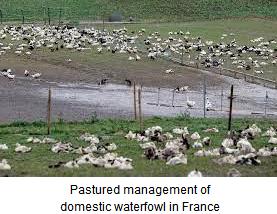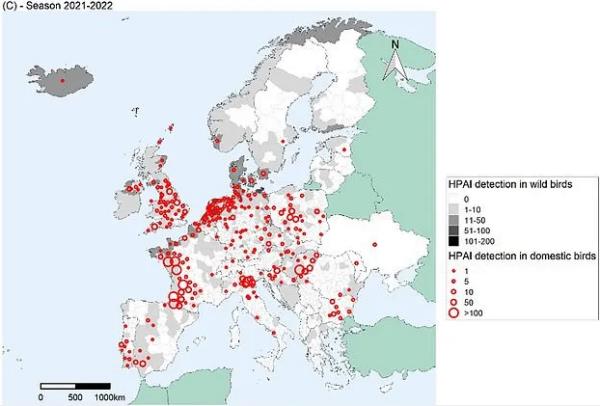 The World Organization of Animal Health has recorded 398 outbreaks of Highly Pathogenic Avian Influenza in 27 European nations involving 398 commercial farms, 151 captive birds, and 613 isolates from wild birds. Although viral detection in colony-breeding seabirds has declined, the incidence in waterfowl has increased. These birds are regarded as more important in dissemination of HPAI virus to commercial farms. Since September 2022, 11 genotypes of H5N1 clade 2.3.4.4b have been identified, three of which circulated during the summer of 2022 with eight new genotypes now having emerged. In addition, H5N1 virus has been detected in wild mammal species in Europe, North America and Asia, although the risk of infection of humans is assessed as low for the general population but proportionately higher for those exposed to commercial poultry or free-living birds.
The World Organization of Animal Health has recorded 398 outbreaks of Highly Pathogenic Avian Influenza in 27 European nations involving 398 commercial farms, 151 captive birds, and 613 isolates from wild birds. Although viral detection in colony-breeding seabirds has declined, the incidence in waterfowl has increased. These birds are regarded as more important in dissemination of HPAI virus to commercial farms. Since September 2022, 11 genotypes of H5N1 clade 2.3.4.4b have been identified, three of which circulated during the summer of 2022 with eight new genotypes now having emerged. In addition, H5N1 virus has been detected in wild mammal species in Europe, North America and Asia, although the risk of infection of humans is assessed as low for the general population but proportionately higher for those exposed to commercial poultry or free-living birds.
Central and Eastern Europe continue to record cases of HPAI. Recently in Hungary a flock of growing turkeys in comprising 25,000 birds was depleted following a diagnosis of HPAI. During November, the National Food Chain Safety Agency reported three outbreaks, all in adjacent areas.
 France is the most impacted nation in Europe with 217 outbreaks on farms identified through late December. Outbreaks are concentrated in areas with high poultry density, especially with free-range housing of waterfowl as used by producers of foie gras. Currently, France is deploying a number of commercially available AI vaccines to determine their effectiveness as a control measure in conjunction with biosecurity of questionable value and traditional depopulation with quarantine and surveillance.
France is the most impacted nation in Europe with 217 outbreaks on farms identified through late December. Outbreaks are concentrated in areas with high poultry density, especially with free-range housing of waterfowl as used by producers of foie gras. Currently, France is deploying a number of commercially available AI vaccines to determine their effectiveness as a control measure in conjunction with biosecurity of questionable value and traditional depopulation with quarantine and surveillance.